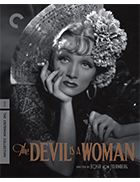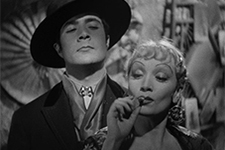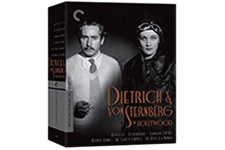| Director: Josef von Sternberg | | Screenplay: John Dos Passos (from the novel The Woman and the Puppet by Pierre Louÿs) | | Stars: Marlene Dietrich (Concha Perez), Lionel Atwill (Captain Don Pasqual “Pasqualito” Costelar), Edward Everett Horton (Governor Don Paquito), Alison Skipworth (Señora Perez), Cesar Romero (Antonio Galvan), Don Alvarado (Morenito), Tempe Pigott (Tuerta), Francisco Moreno (Alphonso) | | MPAA Rating: NR | | Year of Release: 1935 | | Country: U.S. |  |
|  Of the six films that director Josef von Sternberg and star Marlene Dietrich made together for Paramount between 1930 and 1935, their final collaboration, the bluntly titled The Devil Is a Woman, is the funniest and loosest. Perhaps to shake off the combined weight of their previous two films together, the uneven melodrama Blonde Venus (1932) and the baroque Catherine the Great biopic The Scarlet Empress (1934), they ended their legendary collaboration with a film that seems designed to simultaneously emphasize and lampoon Dietrich’s smoldering screen persona, casting her as a wily con artist who mercilessly wraps two very different men around her finger. The devil may be a woman, but the men are fools. Set in Spain at the turn of the century (although, like China in Shanghai Express, it is an exotic fantasy version, bearing little resemblance to the actual country), the film opens during Seville’s Carnival, whose frantic, wildly costumed activity and flowing curtains of streamers and balloons make the Viennese masked ball sequence in Dishonored (1931) look positively spartan. It is here that we first meet Dietrich’s character, Concha Perez, who catches the eye of Antonio Galvan (Cesar Romero, replacing Joel McCrea, who left the production after one day of chafing under von Sternberg’s dictatorial, bullying style). Antonio is a self-possessed young revolutionary on the run from the police, but that doesn’t stop him from tracking Concha back to her home and securing an invite to go riding with her the next day. Just before their date, Antonio runs into Captain Don Pasqual Costelar (Lionel Atwill), an old friend who, upon hearing where he is going and with whom, solemnly offers a lengthy narrative about his own romantic travails with Concha, which take up almost the entire first half of the film. As it turns out, Don Pasqual, who is much older, was drawn into Concha’s alluring web and made the fool over and over and over again, as she squeezed him for money and familial support while making multiple romantic promises that she not only failed to keep, but flaunted in his face (at one point he thinks she is going on a brief ride before they elope together, and instead she takes off with a handsome bull fighter). Don Pasqual ends his story by extracting a promise from Antonio that he will not see Concha, but at this point we know half the film is still left, so that’s probably not going to happen. I will leave the rest of the narrative for you to discover, as it features a number of delightfully wicked and amusing twists and turns that make Concha’s hold over the men in her life that much more insidious (and subversive). After playing her last two roles with von Sternberg relatively straight, Dietrich seems to relish the opportunity to chew the scenery as Concha, flirting and cooing and slinking and pouting and otherwise manipulating both Don Pasqual and Antonio and, in the process, peeling back all their patriarchal authority and commanding masculinity and reducing them to silly pawns who keep coming back and masochistically asking for more. It is not surprising that some critics have viewed the film as a thinly veiled confession by von Sternberg of his own obsession with Dietrich; Lionel Atwill bears a striking physical resemblance to the director, something that critics at the time noted, and the von Sternberg himself wrote that it was his “final tribute” to Dietrich. The screenplay by novelist John Dos Passos, from the 1898 novel La Femme et le pantin (The Woman and the Puppet) by the French writer and poet Pierre Louÿs, is consistently witty and vivacious, matching von Sternberg’s intensely packed visual style with an intriguing storyline and memorable dialogue. As the first of von Sternberg’s films released after the Hollywood studio system began fully enforcing the Production Code, you can sense some of the moral strictures in action, as the third act (which does not appear in the novel) carefully ensures that everyone’s moral lapses and transgressions are appropriately punished, although Dietrich is still allowed to ride off in somewhat ambiguous fashion. Interestingly, while the film proved contentious with the Production Code’s highly specific strictures on sexual behavior, that was nothing compared to the problems it engendered in U.S.-Spanish relations. The Spanish government did not appreciate the depiction of Spanish police and government officials as buffoons, and Spain’s Foreign Ministry demanded Paramount cease international distribution of the film or they would not allow the studio to distribute any more films in Spain. Paramount, under additional pressure from the U.S. State Department, which was worried about a pending trade deal with Spain, acquiesced and actually burned a master print in the presence of the Spanish ambassador, and the only reason the film still exists is because both von Sternberg and Dietrich maintained personal copies (it wasn’t seen again until the 1959 Venice Film Festival). Unfortunately, as enjoyable as it is, The Devil Is a Woman marked the end of von Sternberg’s most prolific and artistically engaging period; as John Baxter described it in his biography of von Sternberg, the film “hammered the last nails in the coffin of von Sternberg’s Hollywood reputation.” It did not perform well at the box office, thus capping the dwindling returns of von Sternberg’s last few films, and his contrast at Paramount was not renewed. It was an ignominious end to the infamous and uneven von Sternberg-Dietrich collaboration. | The Devil Is a Woman Criterion Collection Blu-ray |  The Devil Is a Woman is available exclusively as part of the Criterion Collection’s “Dietrich & Von Sternberg in Hollywood” boxset, which also includes Morocco (1930), Dishonored (1931), Shanghai Express (1932), Blonde Venus (1932), and The Scarlet Empress (1934). The Devil Is a Woman is available exclusively as part of the Criterion Collection’s “Dietrich & Von Sternberg in Hollywood” boxset, which also includes Morocco (1930), Dishonored (1931), Shanghai Express (1932), Blonde Venus (1932), and The Scarlet Empress (1934). | | Aspect Ratio | 1.37:1 | | Audio | English Linear PCM 1.0 monaural | | Subtitles | English | | Supplements | New interviews with film scholars Janet Bergstrom and Homay King; director Josef von Sternberg’s son, Nicholas; Deutsche Kinemathek curator Silke Ronneburg; and costume designer and historian Deborah Nadoolman LandisNew documentary about actor Marlene Dietrich’s German origins, featuring film scholars Gerd Gemünden and Noah IsenbergNew documentary on Dietrich’s status as a feminist icon, featuring film scholars Mary Desjardins, Amy Lawrence, and Patricia WhiteThe Legionnaire and the Lady, a 1936 Lux Radio Theatre adaptation of Morocco, featuring Dietrich and actor Clark GableNew video essay by critics Cristina Álvarez López and Adrian MartinThe Fashion Side of Hollywood, a 1935 publicity short featuring Dietrich and costume designer Travis BantonTelevision interview with Dietrich from 1971Insert book featuring essays by critics Imogen Sara Smith, Gary Giddins, and Farran Smith Nehme | | Distributor | The Criterion Collection | | SRP | $124.95 | | Release Date | July 3, 2018 | | | COMMENTS | | Calling Criterion’s Dietrich & Von Sternberg in Hollywood a major release doesn’t quite do it justice, as the set pulls together six major films that represent the near entirety of one of the most important, fascinating, and influential director-actor collaborations in film history. Not only does the Criterion boxset include all six of the films Marlene Dietrich and Josef von Sternberg made together during their years working for Paramount (the only exclusion is 1930’s The Blue Angel, which was a German production distributed in the U.S. by Paramount), but there is a host of extras that contextualize the films historically and aesthetically and help us better appreciate the artistry of Dietrich and von Sternberg. In terms of sound and image, all six films are in the best condition they’ve ever been in on home video. Given that all of the films were made between 1930 and 1935, they certainly reflect the style and quality of filmstock, cameras, and sound recording technologies at that time, which is how it should be. Morocco and Dishonored, both of which were early synchronized sound films, are both presented in their proper 1.19:1 aspect ratio, which reflects the compromise made at the time to use the silent-era parameters of 35mm film stock and take away from of the image to make room for the optical soundtrack. The other four films are presented in their 1.33:1 or 1.37:1 Academy aspect ratio. Morocco was transferred in 2K from a 35mm safety fine-grain held by the UCLA Film & Television Archive; Dishonored, Blonde Venus, and The Scarlet Empress were all transferred in 4K from 35mm nitrate prints held by the UCLA Film & Television Archive; Shanghai Express was transferred in 4K from a 35mm duplicate negative and a composite fine-grain print by Universal Pictures; and The Devil Is a Woman was also transferred in 4K from a 35mm safety duplicate negative. Extensive digital restoration was performed on all six films, leaving them as clean and blemish-free as one could possibly expect. The image quality of the films gradually improves with each one, not necessarily because of the transfers, but because of the improvements in film stock and the slightly increased resolution of the later sound films. Morocco definitely looks the softest and the grainiest, while the later films have a much sharper appearance, with stronger contrast and finer detail, albeit with plenty of film grain still present. Criterion had previously released The Scarlet Empress on DVD, and the comparison between that transfer and the new one is substantial, with the new high-definition presentation bearing remarkably better depth and detail and with none of the visible wear and tear of the earlier transfer. Like the image quality, the sound quality of each film is very good, although representative of the technological limitations of the time. The monaural soundtrack for Morocco was mastered from a 35mm safety fine-grain; Dishonored, Blonde Venus, and The Scarlet Empress’s soundtracks were mastered from their respective 35mm nitrate prints, while The Devil Is a Woman track was mastered from a 35mm soundtrack positive. And, finally, Shanghai Express’s soundtrack was mastered and restored by Universal from a 35mm optical soundtrack negative. The supplements, which together comprise hours of material, are scattered across the six discs. The Morocco disc features “Weimar on the Pacific” (30 min.), a detailed featurette about Dietrich’s German origins that features interviews with film scholars Gerd Gemünden and Noah Isenberg; “Crazy Love,” a 31-minute interview with film scholar Janet Bergstrom about Morocco’s production and reception; “The Real Amy Jolly” (20 min.), an interview with Deutsche Kinemathek curator Silke Ronneburg (who shows up in another featurette on the Blonde Venus disc) about the real-life woman on whom the Dietrich character is based; and “The Legionnaire and the Lady,” a 60-minute Lux Radio Theatre adaptation of Morocco from 1936 that features Dietrich reprising her role and Clark Gable standing in for Gary Cooper. The Dishonored disc includes “Bodies and Spaces, Fabric and Light” (30 min.), an absolutely fascinating video essay by film scholars Cristina Alvarez Lopez and Adrian Martin about von Sternberg’s unique visual style; “Dietrich Icon” (20 min.), a featurette in which film scholars Mary Desjardine, Amy Lawrence, and Patricia White discuss how Dietrich became a complex and subversive Hollywood icon in her collaboration with von Sternberg; and a video interview with von Sternberg’s son, Nicholas, from 2014. The Shanghai Express disc includes only one supplement, but it is a great one: a 23-minute interview with film scholar Homay King, author of Lost in Translation: Orientalism, Cinema, and the Enigmatic Signifier, about the film’s complicated and, in some regards, regressive depiction of the “exotic” East. The Blonde Venus disc includes “The Fashion Side of Hollywood” (10 min.), a publicity short from 1935 that features Dietrich modeling clothes designed for her by costume designer Travis Banton, and “The Marlene Dietrich Collection” (15 min.), a 15-minute featurette about the immense collection of Dietrich memorabilia housed at the Deutsche Kinemathek in Berlin, featuring an interview with curator Silke Ronneburg. The Scarlet Empress and The Devil Is a Woman discs also have only one supplement each: On the former, we have “Marlene Dietrich in Denmark” (29 min.), a retrospective interview with Dietrich from 1971 that aired on Swedish television, while on the latter we have the audio from a 78 rpm promotional disc of the song “If It Isn’t Pain,” which had to be cut from the film due to restrictions by the Production Code Administration (PCA). Finally, the boxset is packaged with a thick insert book that features essays on each film by critics Imogen Sara Smith, Gary Giddins, and Farran Smith Nehme. |
Copyright © 2018 James Kendrick Thoughts? E-mail James Kendrick All images copyright © The Criterion Collection |




 (3.5)
(3.5)

 The Devil Is a Woman is available exclusively as part of the Criterion Collection’s “Dietrich & Von Sternberg in Hollywood” boxset, which also includes Morocco (1930), Dishonored (1931), Shanghai Express (1932), Blonde Venus (1932), and The Scarlet Empress (1934).
The Devil Is a Woman is available exclusively as part of the Criterion Collection’s “Dietrich & Von Sternberg in Hollywood” boxset, which also includes Morocco (1930), Dishonored (1931), Shanghai Express (1932), Blonde Venus (1932), and The Scarlet Empress (1934).